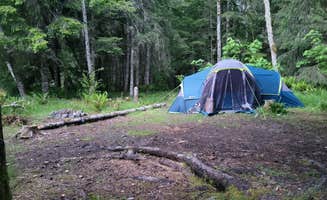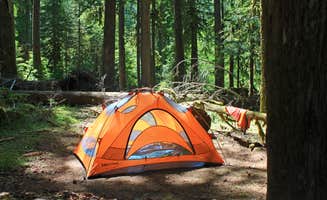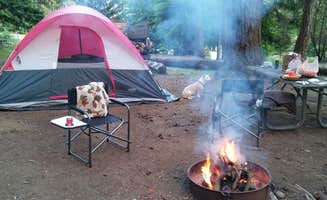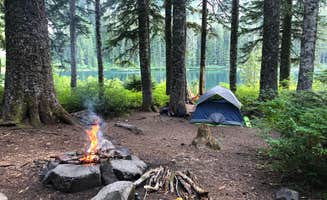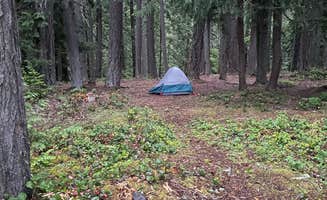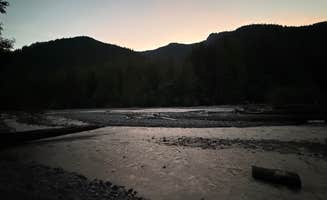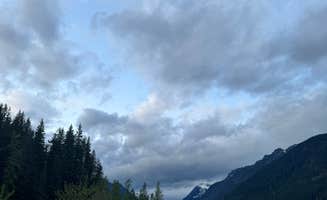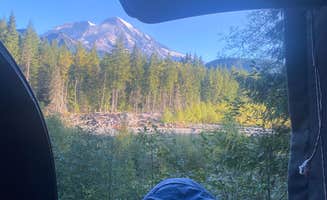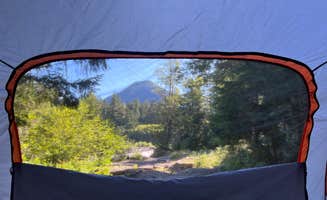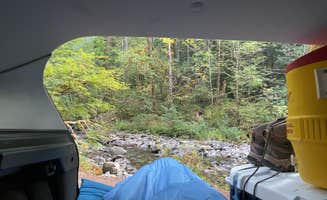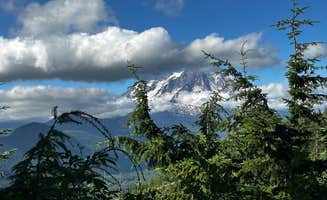Dispersed camping opportunities surround Auburn, Washington, primarily in national forest lands approximately 30-45 miles east of the city. These free campsites typically sit at elevations between 1,500-3,000 feet, with seasonal access affected by snowpack in winter months. Most sites require a Northwest Forest Pass or America the Beautiful pass displayed in vehicles when parked at trailheads or designated forest service roads.
What to Do
Waterside camping near Snoqualmie Pass: Several pull-offs along Keechelus Lake offer direct water access. "Super easy to drive up to the lake and camp, have a fire, hang out and explore! Should always be able to access aside from when the snow is melting, as they don't service the road until it's mostly all melted," notes a camper at Keechelus Lake.
Alpine lake backpacking: For those willing to hike, Annette Lake provides established campsites beside a mountain lake. "We hiked in to Annette Lake to test out some new backpacking gear as we're just getting into backpacking - it was great! The 4 mile hike in was just enough of a challenge for our first time with weight in our packs," shares a visitor to Annette Lake.
Stream-side relaxation: Multiple sites along Forest Road 7300 offer creekside options. "Lots of great creekside campsites along Huckleberry Creek with small swimming spots and fire pits to enjoy," reports a camper at Forest Road 7300 Pull-Off.
What Campers Like
Mountain views: Many free camping areas provide impressive Rainier vistas on clear days. "In the clear morning, we got a beautiful view of Mount Rainier. We got decent Starlink signal with a bar of Verizon," shares a camper at Meadow Landing on Forest Road 7200.
Solitude during weekdays: Many dispersed sites fill quickly on weekends but remain relatively empty mid-week. "Mid week after Labor Day, I had my choice of sites arriving in late afternoon," notes a visitor to Joemma Beach State Park Campground.
Cell service for remote work: Despite the wilderness setting, several sites maintain connectivity. "I travel and work remotely so I'm always looking for free places that have cell reception and this place hits the jackpot. I've come in twice on a Saturday afternoon and have been able to find an open spot with my 18 ft travel trailer, I have Verizon and have 2-3 bars of service," reports a camper at South Fork Snoqualmie River.
What You Should Know
Bridge closures affect access: Several free camping areas require crossing bridges that periodically close. Always check current forest service road conditions before heading out, especially in spring when snowmelt can cause flooding.
Early arrival recommended: "We arrived little later around 6 p.m. And being such a nice day there were only few sites left," notes a camper at Joemma Beach State Park Campground.
Road conditions vary significantly: Many roads leading to dispersed camping require higher clearance vehicles. "Access road is right off the highway and unpaved, has a TON of holes so I wouldn't recommend driving down it without good ground clearance," warns a visitor to South Fork Snoqualmie River.
Seasonal openings fluctuate: Environmental protections can impact accessibility. At Keechelus Lake, "Says when water gets below 2840 ft to protect the fish they close the road and no camping is permitted."
Tips for Camping with Families
Safety considerations: Some areas have natural hazards requiring extra vigilance with children. "Lovely area such beautiful surroundings. But be very cautious as near one of the camp sites are very dangerous plants that are fatal and they are lined all around the campground so not recommended if you have children," warns a camper at White River Dispersed Camping.
Toilet availability: Most dispersed sites lack facilities, so plan accordingly. "Toilet was near by but it ran out of toilet paper next morning due to high number of people camping overnight," reports a visitor to Joemma Beach State Park Campground.
Private beach access: Some sites offer secluded water features. "The second night, I managed to find a spot tucked super far in that had a small private beach. It was farther from the road so you couldn't see or hear anything," shares a camper at White River Dispersed Camping.
Tips from RVers
Big rig accessibility: Select sites can accommodate larger vehicles but often require careful navigation. "This is my favorite dispersed site so far. Plenty of room for larger rigs, very close to a river and lots of woods to explore nearby. There is a single-lane bridge when turning in that could be tricky for a motorhome that is towing," notes a visitor to Ranger Creek Airstrip Dispersed.
Limited turnaround space: Many forest roads narrow significantly, making maneuvering difficult. "For larger rigs - take the second left at a Y-intersection, and then keep to the left and you won't have any trouble getting in. Going to the right at the Y takes you to an area that big rigs might have trouble finding spots or turning around," advises a Ranger Creek Airstrip camper.
Off-season advantages: Cooler months provide better experiences for RVers seeking peace. "Best in late fall when it's cooler. Less loud drunkards. Can fit large RV's down a half mile rough road. I have been a few times in October/November in a 40 ft 5er," reports a Ranger Creek visitor.


